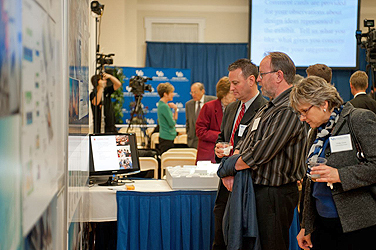News
Finalists announced in medical school design competition

Some of the attendees at yesterday’s design presentation look over some of the proposals. Photo: DYLAN BUYSKES
Four architectural and design teams have submitted proposals to design the new home of the UB School of Medicine and Biomedical Sciences on the Buffalo Niagara Medical Campus.
The teams, which presented their proposals yesterday to individuals from the medical, university, architectural, development, business, political and other interested communities, are Cannon Design and Pelli Clarke Pelli Associates, HOK, Rafael Vinoly Architects with FoitAlbert Associates, and Grimshaw and Davis Brody Bond.
A fifth team—Diller Scofidio + Renfro and Gensler Associates—withdrew from the competition after being awarded commissions to be constructed at the same time as the UB medical school building.
The winner of the competition will be announced in early May and a public reception and exhibition of all the proposals will be presented at that time.
While yesterday’s presentation was not open to the public, faculty members in the UB School of Architecture and Planning talked to the UB Reporter about the four design teams in the running for the commission.
Hiro Hata, associate professor of architecture, described HOK, the largest U.S.-based multidisciplinary design firm and its second-largest interior design firm, as one that has “an outstanding reputation for sustainable design, the advancement of green architecture, communities and cities worldwide, and for the planning and design of innovative educational and institutional facilities and campuses, including medical schools and hospitals.”
Hata pointed out that HOK—the name derives from the surnames of its three founding partners: George Hellmuth, Gyo Obata and George Kassabaum, all graduates of the Washington University School of Architecture in St. Louis—was the architect of UB’s Biomedical Research Building, built in 1995 on the South Campus, and Cooke and Hochstetter halls on the North Campus, completed in 1977.
HOK, he said, designed the first LEED-certified airport terminal, stadium and juvenile detention center—all in the U.S.; the first LEED-certified project in Singapore and the first LEED Gold-certified building in Latin America.
Omar Khan, associate professor and chair of the Department of Architecture, noted that Pelli Clarke Pelli Architects, which teamed with Cannon Design on a proposal, is an internationally renowned firm that holds one of the deepest portfolios of any of the finalists in this competition.
“The firm’s work does not have a singular style,” Khan said, “but it is modern, with strong formal influences taken from the contexts within which they build and the types of buildings they are asked to design.”
A case in point, he said, is the Petronas Twin Towers in Kuala Lumpur, Malaysia, the tallest building in the world until 2004. “The architects took inspiration from local Islamic motifs in formulating its geometry,” he said.
Another example, Khan said, is the Pelli design for the National Museum of Contemporary Art in Osaka, Japan. “It was designed as a sculpture whose form alluded to reeds or bamboo stalks swaying along a riverbank.
“Pelli and Cannon Design present a formidable team with tremendous experience that has designed just about every type of building,” he added.
Annette LeCuyer, professor of architecture, called Grimshaw Architects, another contender, “a leading global practice with experience encompassing architecture, infrastructure and industrial design. Their work reflects a strong belief in building the public realm in the city, close attention to detailing and materials, and an impressive commitment to sustainable design.”
The firm’s recent work, she said, includes an academic/social hub and 25-year master plan, both for New York University; a medical school and research center for University College London; and a new mass transit center in Manhattan.
Grimshaw will partner with Davis Brody Bond Architects and Planners, one of the nation’s leading architectural design firms. Known for innovative solutions to complex design challenges, the firm has designed university facilities, housing and corporate offices, as well as industrial and institutional buildings, including research facilities for Columbia and Princeton universities and the National Sept. 11 Memorial and Museum at the World Trade Center.
Brian Carter, professor of architecture, stressed that in Buffalo, a city where “inspired patronage has created an internationally renowned collection of modern architecture set within landscapes devised by Frederick Law Olmsted, it is vital that the new buildings for tomorrow are designed by the most notable architects today.”
“In this context,” he said, “the creation of a competition to design a new home for the University at Buffalo School of Medicine and Biomedical Sciences on a site in the heart of the city, and the formulation of a truly international shortlist of architects that includes designers such as Rafael Vinoly are both very encouraging signs.”
Rafael Vinoly Architects, founded in New York in 1983 by the Argentine-born Vinoly, has become known internationally for its architectural projects around the globe, including the Carrasco International Airport in Montevideo, Uruguay; Lehman College Physical Education Facility; the Penn State Information Sciences and Technology Building; Duke University’s Nasher Museum of Art; the UCLA NanoSystems Institute; and CUNY’s Spitzer School of Architecture, Urban Design and Landscape Architecture, among others.
According to Vinoly, “Architecture is a dialogue with the forces of life. As a major form of social intervention, its essential responsibility is to elevate the public realm. In every project, I seek to maximize the opportunity for civic investment with a goal of forming iconic works that fulfill the needs of the client. For me, this makes architecture the most unique form of artistic endeavor.”
On this project, Vinoly has partnered with FoitAlbert Associates of Buffalo, one of the region’s best-known firms and the winner of dozens of national design, engineering, historic preservation and planning awards. Its university projects include the Alfiero Center, UB School of Management, North Campus; Erie and Mason halls, Fredonia State College; Trinity Hall, Hilbert College; and the Campus Center, University at Albany.
FoitAlbert also designed Fletcher Music Hall and oversaw the restoration of Wensley Guest House and Fowler-Kellogg Art Center, all at the Chautauqua Institution.

Reader Comments